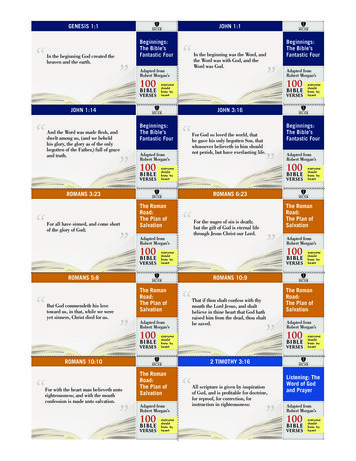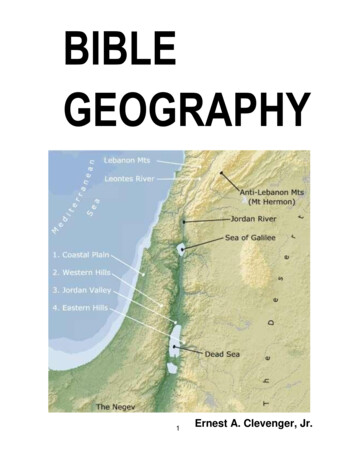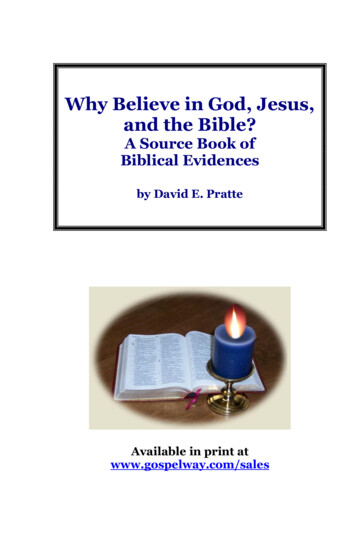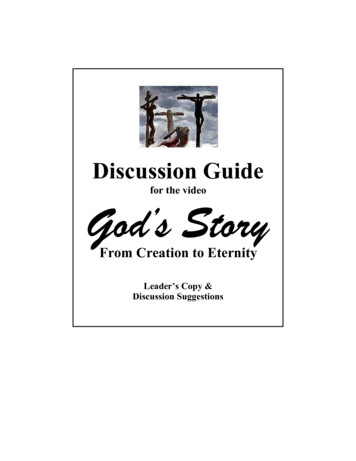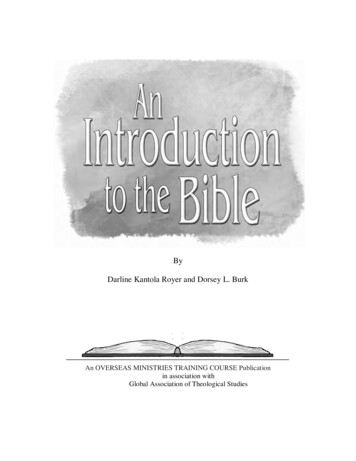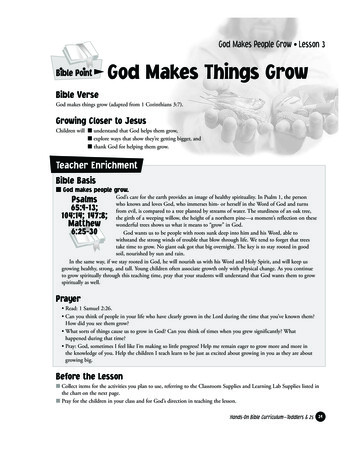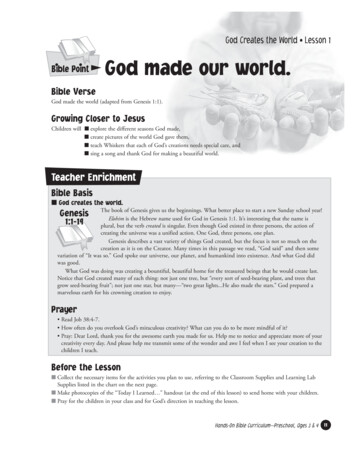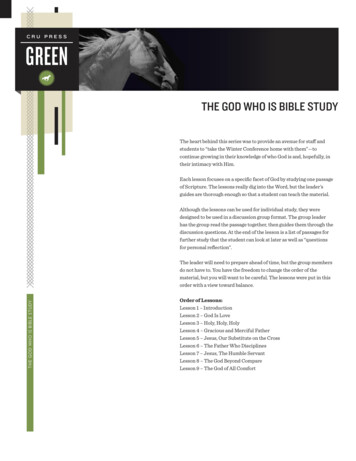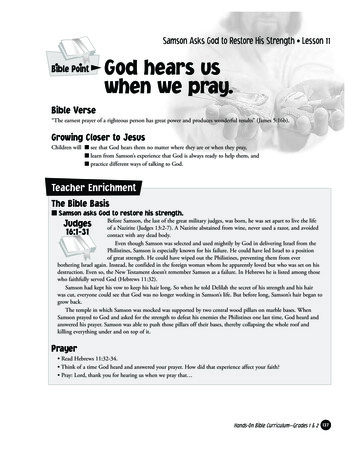
Transcription
Praise Jesus!Samson Asks God to Restore His Strength Lesson 11Bible PointGod hears uswhen we pray.Bible Verse“The earnest prayer of a righteous person has great power and produces wonderful results” (James 5:16b).Growing Closer to JesusChildren will n see that God hears them no matter where they are or when they pray,n learn from Samson’s experience that God is always ready to help them, andn practice different ways of talking to God.Teacher EnrichmentThe Bible Basisn Samson asks God to restore his strength.Judges16:1-31Before Samson, the last of the great military judges, was born, he was set apart to live the lifeof a Nazirite (Judges 13:2-7). A Nazirite abstained from wine, never used a razor, and avoidedcontact with any dead body.Even though Samson was selected and used mightily by God in delivering Israel from thePhilistines, Samson is especially known for his failure. He could have led Israel to a positionof great strength. He could have wiped out the Philistines, preventing them from everbothering Israel again. Instead, he confided in the foreign woman whom he apparently loved but who was set on hisdestruction. Even so, the New Testament doesn’t remember Samson as a failure. In Hebrews he is listed among thosewho faithfully served God (Hebrews 11:32).Samson had kept his vow to keep his hair long. So when he told Delilah the secret of his strength and his hairwas cut, everyone could see that God was no longer working in Samson’s life. But before long, Samson’s hair began togrow back.The temple in which Samson was mocked was supported by two central wood pillars on marble bases. WhenSamson prayed to God and asked for the strength to defeat his enemies the Philistines one last time, God heard andanswered his prayer. Samson was able to push those pillars off their bases, thereby collapsing the whole roof and killing everything under and on top of it.Prayer Read Hebrews 11:32-34. Think of a time God heard and answered your prayer. How did that experience affect your faith? Pray: Lord, thank you for hearing us when we pray that Hands-On Bible Curriculum—Grades 1 & 2 137
Lesson 11Before the Lessonn Collect items for the activities you plan to use, referring to the Classroom Supplies and Learning Lab Supplies listed inthe chart.n Make photocopies of the “Growing Together” handout (at the end of this lesson) to send home with your children.n Pray for your students and for God’s direction in teaching the lesson.This Lesson at a GlanceWelcomeAttentionGrabberBibleExploration &ApplicationWhat Children Will DoClassroom SuppliesWelcome!—Receive a warm“Prayer Name Tags” (p. 134),safety scissors, markers, tapeGuess Who—Guess the identitiesof classmates who are disguisingtheir voices, and discover that Godalways hears those who pray tohim.BibleNever Too Far—Listen to aBibleSamson’s Melodrama—Bible, safety scissors,construction paper, CD playerFreedom Prayer—Experiencethe power of prayer firsthand, and“free” themselves from feelinghelpless.Bible, CD playerSpringing to Hear—DiscoverBiblewelcome from the teacher, andmake name tags.whispered message, and learnfrom Psalm 6:9 that God hears theirprayers no matter where they areor how softly they pray.Participate in the story of Samson’sfinal prayer to God from Judges16:1-31.how it’s harder to hear as the noiselevel increases, and learn from1 Kings 9:3a that it’s never hard forGod to hear us.ClosingNo Matter How You Say It—Explore ways of giving answers andtalking to God.138 Hands-On Bible Curriculum—Grades 1 & 2Learning Lab Supplies
Samson Asks God to Restore His StrengthWelcomeSUPPLIES: “Prayer Name Tags” (p. 134), safety scissors, markers, tape Greet each child individually with an enthusiastic smile. Thank each child for coming to class today. As children arrive, ask them about last week’s “Growing Together” discussion. Use questions such as “How did God answer your prayerslast week?” and “When did your family pray together?” Say: Today we’re going to learn that God hears us when we pray. Hand out the name tags children made during Lesson 10, and help children attachthe name tags to their clothing. If some of the name tags were damaged, or if childrenweren’t in class last week, have them make new name tags using the photocopiablehandout. Tell children that the attention-getting signal you’ll use during this lesson will beblowing the bird whistle. Ask children to respond by raising their hands as they stoptalking and focus their attention on you. Rehearse the signal with the children, tellingthem to respond quickly so you have plenty of time for all the fun activities plannedfor this lesson.It’s important to say the Bible Pointjust as it’s written in each activity.Repeating the Bible Point over andover will help children remember itand apply it to their lives.Attention Grabbern Guess WhoSUPPLIES: BibleSay: Let’s play a game called Guess Who. You’ll scatter around the roomand sit on the floor with your eyes shut. Then I’ll tap someone on theshoulder. The person I tap will disguise his or her voice and say, “Goodprayers have power.” If I tap you, try not to sound like yourself. Everyoneelse will guess who spoke. If you think you know whose voice you heard,raise your hand. The class will have three guesses. Remember to keep youreyes closed!When children are scattered around the room and sitting with their eyes closed,tap a child, and have him or her say, “Good prayers have power.” If a child correctlyidentifies the speaker, he or she becomes the next tapper. If the speaker hasn’t beenidentified after three guesses, have the students open their eyes to see who it is. Playseveral rounds.Then gather the children, and ask: Was it easy or hard to figure out who was speaking? Explain. (Hard,because they sounded different; easy, I know my friend’s voice.) Do you think God has trouble figuring out who’s speaking to him whenwe pray? Explain. (No, because God knows and sees everyone; yes, because so manypeople talk to God.)Say: God hears us when we pray. We’re important to God, and healways knows who we are. We can always count on God to hear us. Listen towhat the Bible says about our prayers. This is our Bible verse for today, andit comes from James 5:16: “The earnest prayer of a righteous person hasHands-On Bible Curriculum—Grades 1 & 2 139
Lesson 11great power and produces wonderful results.” That means that when weare serious about praying to God, our good prayers have power, and it’s funto see how God answers them. Let’s learn more about that.First- and second-graders maysometimes feel small andinsignificant, and they may wonderif God really listens to themwhen they pray. Take time d uringtoday’s lesson and throughout theremaining weeks of the quarter toreassure kids that God always hearsthem when they call and that theirprayers are very important to him.Bible Exploration & Applicationn Never Too FarSUPPLIES: BibleSay: We’re going to form two groups: the Whisperers and the Listeners.I’m going to whisper some exciting news to the Whisperers. When I say“go,” the Whisperers will whisper it very softly to the Listeners. I want theListeners to listen closely so you can tell me what you hear.Form two groups. Have the groups stand against opposite walls, facing away fromeach other. Choose one group to be Whisperers.Whisper this exciting news to the whispering group: God hears us when wepray. On “go” have the Whisperers repeat the message in a low whisper. Then ask theListeners what they heard.Have the Listeners move closer to the Whisperers, and have the Whisperersrepeat the message softly until the Listeners can hear and repeat the message. Thenhave each Listener pair up with a Whisperer for this discussion. Say: If you were aListener, tell your partner why you couldn’t hear the first time the excitingnews was given.Then blow the bird whistle, and bring everyone together. Ask the Whisperers to tellwhat their partners said. Children might give responses such as “because they whisperedtoo quietly” or “because the Whisperers were too far away.”Say: If we want people to hear us, we need to speak clearly.Ask: Where should we go and how should we speak so God will hear uswhen we talk to him in prayer? (We can pray anywhere; we should go to church.) Do you think God can hear us if we pray silently? Explain. (Yes, becauseGod knows what we’re thinking; I’m not sure; yes, because God hears everything.)Say: God hears us when we pray. Listen to what the Bible says aboutprayer in Psalm 6:9. Read Psalm 6:9 aloud. A plea is something serious we are asking God about.Ask: Where and when do you like to pray? Why? (In church because it’squiet; at bedtime because then I sleep better.) Do you think there’s ever a time God doesn’t hear our prayers? Explain.(No, because God always listens; no, God never sleeps; God is always watching.)Say: It doesn’t matter where we are or how we pray. God always hears.Now, just for fun, whisper something nice in your partner’s ear, such as “Ilike you” or “You’re nice.”140 Hands-On Bible Curriculum—Grades 1 & 2
Samson Asks God to Restore His Strengthn Samson’s MelodramaSUPPLIES: Bible, safety scissors, construction paper, CD playerHave children stay with their partners.track 10Open your Bible to Judges 16:1-31, and show the passage to the children.Say: Today’s story comes from the book of Judges. It’sabout a man named Samson who asked God to answer animportant prayer. Before we begin, let’s make props to help us enjoy thestory. Decide which partner will be Samson and which will be Delilah.Give each pair scissors and two sheets of construction paper. One sheet should bebrown or black. Demonstrate how to make the following props for the story.Delilah’s hair bow: Fold the brown or black paper in half, and cut a simple bow asshown in the margin diagram.Samson’s hair: Fold the brown or black paper down about one-third of the waylengthwise. Leaving about 11/2 inches on each side, cut a half circle from the folded edgeof the wig. Leave enough on the short edge for “bangs.” Make vertical cuts 1/4 to 1/2 inchapart all along the paper. (See the margin diagram.)When the props are made, have partners sit facing each other. Say: If you’replaying Samson, hold the hairpiece up to your head each time you hearSamson’s name. If you’re playing Delilah, hold the hair bow up to your headeach time you hear Delilah’s name.Play “Samson’s Melodrama” (track 10) on the CD.After the story, collect the bows and wigs, and gather the children. Let the childrentake the props home to retell the story to their families.Ask: What made Samson lose his strength? (He told his secret; cutting offhis hair.) Do you think God was unhappy with Samson? Why? (Yes, because Samsondidn’t obey God; yes, because God took away his strength.)Say: Samson forgot about the promises he made to God. He cared moreabout making Delilah happy than keeping his promise to never cut his hair.Then God took away the strength he had given Samson.Ask: How do you think Samson felt when his enemies captured him andtook him to prison? (Sad; scared.) When did Samson’s strength come back? (When he prayed; when his hairgrew again.)Say: God helped Samson when he prayed. And God wants to help us.God hears us when we pray.Bible InsightSamson’s amazing strengthwas not actually derivedfrom his long hair but fromhis special relationship toGod that was signified by hisuncut hair. When Samsonwas tempted by Delilah andallowed his hair to be cut,he broke his Nazirite vow tonever cut his hair. BecauseSamson broke his vow toGod in this manner, God leftSamson, and with God wentSamson’s strength.n Freedom PrayerSUPPLIES: Bible, CD playertrack 11Before class, twist the coil bracelets together sothey are connected at one point. Practice puttingthem on like handcuffs and then stretching yourhands apart until they separate from each other.Hands-On Bible Curriculum—Grades 1 & 2 141
Lesson 11Say: Let’s review our Bible verse for today. It comes from James 5:16,and this is how it goes: “The earnest prayer of a righteous person hasgreat power and produces wonderful results.” Can you say that with me?“The earnest prayer of a righteous person has great power and produceswonderful results.” That means that when we are serious about what we arepraying for and we try our best to obey God and do what we’re told, Godwill respond wonderfully. When did Samson get his strength back? It waswhen he prayed.Ask: Have you ever done something wrong or been so worried that justthinking about your problem made you feel helpless and sad? Explain. (Yes,once I lied to my parents and I felt really bad; yes, I was really worried about going onan airplane for the first time, and every time I thought about it, I got really scared.) What did you do to feel better? (I told my parents the truth, and they forgaveme; I prayed when I was on the airplane, and that made me feel better.)Say: Samson was helpless and sad because he disobeyed God and so Godtook away his strength. Samson felt sorry for what he had done, though.When Samson prayed and asked God to forgive him, God forgave Samsonand gave him his strength back. Put the twist coil bracelet “handcuffs” aroundyour wrists. Samson had been so unhappy that it must have felt like he waswearing handcuffs—that’s how helpless he felt. But when he prayed, Godgave him back his strength, and Samson was able to get free. Stretch yourhands until the bracelets separate. Just like Samson did, we can ask God to helpus, because God always hears us when we pray.Ask: Do you remember a time you felt sure God had heard your prayer?Tell us about that time. (I prayed for my mom and dad to come home safely, andthey did; I prayed that God would help me do well on a test at school, and I know hehelped me; I prayed that God would help me be nice to my sister, and I wasn’t mad ather anymore.) What is making you worry that you need to pray to God about rightnow? (I yelled at my sister today, and I’m sorry; I’m worried about a test I have to takethis week; I lied about getting my homework done, and I want God to forgive me.)Say: It doesn’t matter where we are or what we are doing or how badlywe feel. Just as God heard Samson when he prayed, God hears us whenwe pray. Let’s pray right now! Each of you may take a turn to pray out loudor pray silently and ask God for his help and forgiveness for the thing youare worried about.Have children come up one at a time and put on the handcuffs. Encourage them topray and then to stretch their hands and break the handcuffs. Tell the other children tocheer as each person breaks the handcuffs. When all the children have had a turn, prayaloud for the class, thanking God for hearing us when we pray.Pray: Dear God, thank you for loving us. We’re so glad that we can cometo you whenever we need help, and you hear us when we pray. In Jesus’name, amen.Play “Earnest Prayer” (James 5:16), track 11 on the CD. Play it a second time, andencourage the children to sing along with the CD. Lyrics are at the back of this book.142 Hands-On Bible Curriculum—Grades 1 & 2
Samson Asks God to Restore His StrengthHANDS-ON BIBLEFor this activity, provide each child with a blank notebook andsomething to write with. Say: God is a friend who always listens.We can talk to God whenever we want, and God hears uswhen we pray. Let’s read about that in our Hands-On Bibles.Have children turn to Psalm 35 in their Hands-On Bibles andread the Fun Fact called “Talk It Over” aloud. Distribute notebooks and writinginstruments, and lead children through the activity. On the left-hand side of theirnotebooks, have them draw or write about one of the worst things that has ever happened to them. On the right-hand side, have them draw or write about one ofthe best things that has ever happened to them.When children have finished, ask: How was talking to God on paper thesame as or different from talking out loud to him? (It was different because it’sharder for me to draw than to talk; it was the same because I was telling God what Iwas thinking about, and he knows everything anyway.) Which way do you like better? (Talking out loud because it’s easier; drawinga picture because I like to draw.) Do you think God hears one kind of prayer more than the other?Explain. (No, I think God hears both kinds of prayers the same; yes, I think Godhears me more when I talk because I can talk faster than I can write, so I say more.)Say: Whether we say it out loud with words or draw it on paper withpictures, God hears us when we pray. You can keep your prayer journalsand draw or write about other things you want to talk to God about. Anddon’t forget to write down the good things that happen, too, when Godanswers and helps you!n Springing to HearSUPPLIES: BibleGather the children in a circle. Have one child stand in the centerof the circle. Give him or her a coil bracelet, and demonstrate how tostretch it and shoot it like a rubber band.Say: When the person in the center shoots the coilbracelet at your feet, pick it up and say, “God hears us when we pray,BUZZ, BUZZ, BUZZ, BUZZ ” Keep buzzing and move to the center of thecircle to shoot the coil bracelet at another person’s feet. Once you startbuzzing, don’t stop until I give the signal. We’ll keep going until everyone isbuzzing.When everyone is buzzing, blow the bird whistle, and wait for children’s response.Return the coil bracelet to the Learning Lab.Ask: What happened as more and more people started buzzing? (It gotnoisy; it was harder and harder to hear the person in the center.) Do you think that’s what it’s like when lots of people pray to God at thesame time? Explain. (Yes, it must be noisy; no, it’s not noisy to him.)Say: Sometimes when it’s noisy, I blow the bird whistle so everyone willHands-On Bible Curriculum—Grades 1 & 2 143
Lesson 11quiet down. Then I can hear you, and you can hear me. But it’s different withGod. It doesn’t matter if there’s lots of noise. The Bible tells us that Godhears us when we pray. There’s a good example of that in 1 Kings 9:3a. Read1 Kings 9:3a aloud. A petition is a very important request. We can talk to Godabout very important things, and he will listen.Ask: Do you like it when people talk to you? Why or why not? (Yes, itmakes me feel good; yes, I know they care; otherwise, I’d be lonely.) Do you think God likes it when we talk to him? Explain. (Yes, because heloves us; he cares about us; he wants to hear from us.) How can God listen to everybody who prays to him? (God can do anything;God has enough time for everybody; because he’s God.)Say: God always has time to listen. But listening isn’talways easy for us. Long ago when Jesus lived here onearth, he tried to tell people all about God, but theydidn’t always listen. He even died on the cross forthose people. Sometimes when God tries to tell us about himself, we don’t listen, either, do we? Thankfully,Jesus died on the cross for us, too. If we pray and askforgiveness for our sins, God will forgive us, and we can becomefriends with Jesus. Jesus is a forever friend who will always listen!We might need some extra help listening in our next activity, sowe’ll need to use the animal ears.Closingn No Matter How You Say ItSUPPLIES: noneHave children form pairs and decide which partner will talkand which will listen. Have one pair come to the front of theclassroom and stand facing each other. Give the animal ears tothe listener, and say: Listeners, you’ll wear these animalears. Talkers, when I ask, “What do you want?” tell yourlistener anything you want. For example, you might say, “I want a pizza” or“I want 10.” I’ll ask, “What do you want?” two times. Give the same answereach time, but say it the way I tell you to say it. For instance, I might say,“Whisper your answer” the first time and “Yell your answer” the secondtime. Here we go.Give each talker two distinctly different instructions from this list: Whisper your answer. Jump up and down as you answer. Make an angry face as you answer. Turn away from your partner as you answer. Look up at the ceiling as you answer. Stomp your feet as you answer. Sing your answer. Speak your answer softly with your eyes closed.144 Hands-On Bible Curriculum—Grades 1 & 2
Samson Asks God to Restore His StrengthAfter each pair has had a turn, collect the animal ears and return them to theLearning Lab. Have pairs discuss these questions: Listeners, what was your favorite way of hearing the answer? (When the person sang; when the person spoke softly.) Talkers, what was your favorite way of giving the answers? (Jumping upand down while I gave my answer; yelling the answer.)Blow the bird whistle, and wait for children to respond. Form a circle.Say: There are lots of different ways we can talk to people. In our game,we tried lots of different ways.Ask: How do you think God wants us to talk to other people? (Nicely;softly; not angrily.) How do you think other people like to hear us? (When we talk quietly; whenwe say please and thank you; when we are nice.)Say: Those are good answers. Just as there are many good ways to talk topeople, there are many ways to talk to God. We can say prayers before weeat, when we’re at school, when we’re standing or sitting, and when we’respeaking or singing or silent. No matter how or when we talk to him, Godhears us when we pray.Have each child tell one way he or she will talk to God this week. Then close witha prayer similar to this one: Dear God, thank you for hearing us when we pray.Thank you for watching over us and answering our prayers in the very bestway. In Jesus’ name, amen.Growing closer to Jesus extendsbeyond the classroom.Photocopy the “Growing Together” handout (at the endof this lesson) for this week, and send it home with yourchildren. Encourage children and parents to use thehandout to plan meaningful activities on this week’stopic. Follow up the “Growing Together” activities nextweek by asking children what their families did together.Hands-On Bible Curriculum—Grades 1 & 2 145
Prayer 11:God hears us whenwe pray.Key Verrasyeer ofr haasrnest p, no eaheeeahas seeno ey“N“Tgreinedasimagatsodnhhasminteoug,hand snoperrderdhearionoslewesed for thfuducparanhdaspropreGodat er).wphowbamhim5:”16s”o (Je eslthlovresuw2:9b).(1 CorinthiansBible StotoryrestoreGodSamson asksrehis st ngth.1Judges 16:1-3This week your child learned that God hears us when wepray, whether we pray silently or out loud, in a church or inbed at night. Children discovered that when they pray, Godwill hear and answer their prayers.Prayer PartyHave a wiener roast in a fireplace, overa campfire, or on a barbecue grill. Asyou thank God for the food, point out thesmoke drifting up to the sky, and talkabout how your prayers rise toward God.From the HeartFold a 5x5-inch square of paper in half. Help yourchild draw half a heart shape on the fold, and addlines to make it resemblean ear. Cut around theouter edge of the ears.Then open the fold andlay the ears flat. Askyour child what shape thetwo ears make (a heart).Explain that God listensto our prayers through ears of love. Because Godloves us and wants to take care of us, he hears uswhen we pray.146Talking to GodHelp your child choose a family or a specific issuein the news to pray about. If you choose an issuesuch as homeless people in your area, follow thenews carefully and pray together about that issue.If you choose to pray for a family or an olderperson, you might also send homemade cards ofencouragement.Music MakersMake mealtime prayers special this week by settingthem to music. Sing this prayer to the tune of “TheMulberry Bush.”God is great, and God is good.We thank you for our food.God is great, and God is good.Thank you for our food.Permission to photocopy this handout from Group’s Hands-On Bible Curriculum , Grades 1 & 2, granted for local church use.Copyright Group Publishing, Inc., 1515 Cascade Ave., Loveland, CO 80538. group.com
Samson prayed to God and asked for the strength to defeat his enemies the Philistines one last time, God heard and answered his prayer. Samson was able to push those pillars off their bases, thereby collapsing the whole roof and killing everything under and on top of it. Prayer Read Hebrews 11:32-34.
